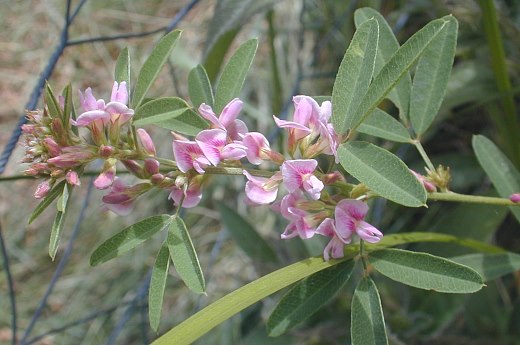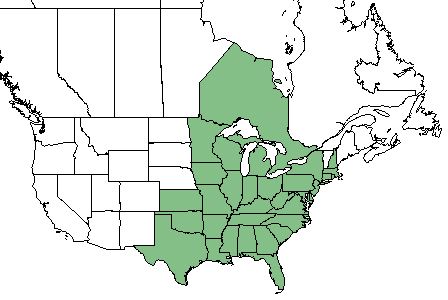Difference between revisions of "Lespedeza virginica"
| Line 32: | Line 32: | ||
==Ecology== | ==Ecology== | ||
===Habitat=== <!--Natural communities, human disturbed habitats, topography, hydrology, soils, light, fire regime requirements for removal of competition, etc.--> | ===Habitat=== <!--Natural communities, human disturbed habitats, topography, hydrology, soils, light, fire regime requirements for removal of competition, etc.--> | ||
| − | ''L. virginica'' proliferates in sandhills, woodlands, and woodland borders. <ref name= "Weakley 2015"> Weakley, A. S. (2015). Flora of the Southern and Mid-Atlantic States. Chapel Hill, NC, University of North Carolina Herbarium. </ref> | + | ''L. virginica'' proliferates in sandhills, woodlands, and woodland borders. <ref name= "Weakley 2015"> Weakley, A. S. (2015). Flora of the Southern and Mid-Atlantic States. Chapel Hill, NC, University of North Carolina Herbarium. </ref> Specimens have been collected from annually burned pineland, drying sandy loam of pine-oak woods, border of roadside and woodland, beech-magnolia forest, old field, old field with pine woods, open stand of shortleaf pine with snady clay, young slash pine plantation, disturbed regions such as roadsides and fields, and longleaf pine wiregrass ridge. <ref name = "FSU herbarium"> URL: http://herbarium.bio.fsu.edu. Last accessed: June 2018. Collectors: A.F. Clewell, Loran C. Anderson, Gary Knight, R. Kral, R.K. Godfrey, Richard S. Mitchell, R. Komarek, Norman E. Hill, Delzie Demaree, D.S. Correll. States and counties: Florida (Leon, jackson, washington, Holmes, Okaloosa, jefferson, Madison, Liberty) Goergia (Thomas, Grady, Haralson, Marion, Chattooga, Coweta, Talbot, Meriwether, Webster, Lee, Miller, Crisp, Appling, Wheeler, Wilcox, Dodge, Walker, Clarke, Long, De Kalb, Heard, Randolph, Clay, Decatur, Steart, Muscogee, Troup, Chattahoochee, Walker, Baker, Harris)</ref> |
| + | |||
===Phenology=== <!--Timing off flowering, fruiting, seed dispersal, and environmental triggers. Cite PanFlora website if appropriate: http://www.gilnelson.com/PanFlora/ --> | ===Phenology=== <!--Timing off flowering, fruiting, seed dispersal, and environmental triggers. Cite PanFlora website if appropriate: http://www.gilnelson.com/PanFlora/ --> | ||
''L. virginica'' flowers August-October. <ref name= "PanFlora"> PanFlora Author: Gil Nelson URL: [http://www.gilnelson.com/PanFlora/ http://www.gilnelson.com/PanFlora/] Date Accessed: 5/24/18 </ref> Stems mostly erect, can be ascending, usually branched; leaves alternate, pinnately trifoliolate compound; leaflets 3, linear to narrowly oblong, without stipels; fruit is a 1-seeded, indehiscent pod. <ref name= "Gee 1994"> Gee, K. L., et al. (1994). White-tailed deer: their foods and management in the cross timbers. Ardmore, OK, Samuel Roberts Noble Foundation. </ref> | ''L. virginica'' flowers August-October. <ref name= "PanFlora"> PanFlora Author: Gil Nelson URL: [http://www.gilnelson.com/PanFlora/ http://www.gilnelson.com/PanFlora/] Date Accessed: 5/24/18 </ref> Stems mostly erect, can be ascending, usually branched; leaves alternate, pinnately trifoliolate compound; leaflets 3, linear to narrowly oblong, without stipels; fruit is a 1-seeded, indehiscent pod. <ref name= "Gee 1994"> Gee, K. L., et al. (1994). White-tailed deer: their foods and management in the cross timbers. Ardmore, OK, Samuel Roberts Noble Foundation. </ref> | ||
Revision as of 10:51, 29 June 2018
Common name: slender lespedeza [1], Virginia lespedeza [2]
| Lespedeza virginica | |
|---|---|

| |
| Photo by the Illinois Wildflowers Database | |
| Scientific classification | |
| Kingdom: | Plantae |
| Division: | Magnoliophyta - Flowering plants |
| Class: | Magnoliopsida - Dicots |
| Order: | Fabales |
| Family: | Fabaceae |
| Genus: | Lespedeza |
| Species: | L. virginica |
| Binomial name | |
| Lespedeza virginica L. | |

| |
| Natural range of Lespedeza virginica from USDA NRCS Plants Database. | |
Contents
Taxonomic Notes
Synonyms: none
Varieties: none
Description
L. virginica is a perennial forb/herb of the Fabaceae family native to North America and Canada. [1]
Distribution
L. virginica is found in the eastern half of the United States, as well as the Ontario region of Canada. [1]
Ecology
Habitat
L. virginica proliferates in sandhills, woodlands, and woodland borders. [2] Specimens have been collected from annually burned pineland, drying sandy loam of pine-oak woods, border of roadside and woodland, beech-magnolia forest, old field, old field with pine woods, open stand of shortleaf pine with snady clay, young slash pine plantation, disturbed regions such as roadsides and fields, and longleaf pine wiregrass ridge. [3]
Phenology
L. virginica flowers August-October. [4] Stems mostly erect, can be ascending, usually branched; leaves alternate, pinnately trifoliolate compound; leaflets 3, linear to narrowly oblong, without stipels; fruit is a 1-seeded, indehiscent pod. [5]
Fire ecology
L. virginica increases in abundance with increasing fire frequency. [6]
Conservation and Management
L. virginica is listed as threatened by the New Hampshire Natural Heritage Inventory Division of Land and Forests and by the Wisconsin Department of Natural Resources Bureau of Endangered Resources. [1]
Cultivation and restoration
Photo Gallery
References and notes
- ↑ 1.0 1.1 1.2 1.3 USDA Plant Database https://plants.usda.gov/core/profile?symbol=LEVI7
- ↑ 2.0 2.1 Weakley, A. S. (2015). Flora of the Southern and Mid-Atlantic States. Chapel Hill, NC, University of North Carolina Herbarium.
- ↑ URL: http://herbarium.bio.fsu.edu. Last accessed: June 2018. Collectors: A.F. Clewell, Loran C. Anderson, Gary Knight, R. Kral, R.K. Godfrey, Richard S. Mitchell, R. Komarek, Norman E. Hill, Delzie Demaree, D.S. Correll. States and counties: Florida (Leon, jackson, washington, Holmes, Okaloosa, jefferson, Madison, Liberty) Goergia (Thomas, Grady, Haralson, Marion, Chattooga, Coweta, Talbot, Meriwether, Webster, Lee, Miller, Crisp, Appling, Wheeler, Wilcox, Dodge, Walker, Clarke, Long, De Kalb, Heard, Randolph, Clay, Decatur, Steart, Muscogee, Troup, Chattahoochee, Walker, Baker, Harris)
- ↑ PanFlora Author: Gil Nelson URL: http://www.gilnelson.com/PanFlora/ Date Accessed: 5/24/18
- ↑ Gee, K. L., et al. (1994). White-tailed deer: their foods and management in the cross timbers. Ardmore, OK, Samuel Roberts Noble Foundation.
- ↑ Burton, J. A. (2009). Fire frequency effects on vegetation of an upland old growth forest in eastern Oklahoma. Environmental Science. Stillwater, Oklahoma, Oklahoma State University. Bachelor: 78.